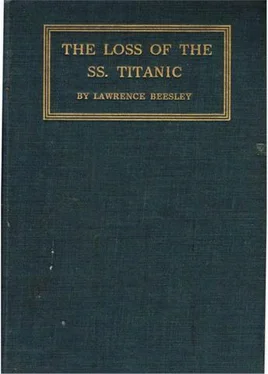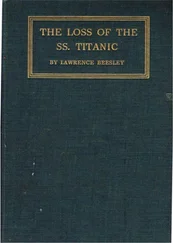But to return for a time to the means taken to attract the notice of other ships. The wireless operators were now in touch with several ships, and calling to them to come quickly for the water was pouring in and the Titanic beginning to go down by the head. Bride testified that the first reply received was from a German boat, the Frankfurt, which was: “All right: stand by,” but not giving her position. From comparison of the strength of signals received from the Frankfurt and from other boats, the operators estimated the Frankfurt was the nearest; but subsequent events proved that this was not so. She was, in fact, one hundred and forty miles away and arrived at 10.50 A.M. next morning, when the Carpathia had left with the rescued. The next reply was from the Carpathia, fifty-eight miles away on the outbound route to the Mediterranean, and it was a prompt and welcome one—“Coming hard,” followed by the position. Then followed the Olympic, and with her they talked for some time, but she was five hundred and sixty miles away on the southern route, too far to be of any immediate help. At the speed of 23 knots she would expect to be up about 1 P.M. next day, and this was about the time that those in boat 13 had calculated. We had always assumed in the boat that the stokers who gave this information had it from one of the officers before they left; but in the absence of any knowledge of the much nearer ship, the Carpathia, it is more probable that they knew in a general way where the sister ship, the Olympic, should be, and had made a rough calculation.
Other ships in touch by wireless were the Mount Temple, fifty miles; the Birma, one hundred miles; the Parisian, one hundred and fifty miles; the Virginian, one hundred and fifty miles; and the Baltic, three hundred miles. But closer than any of these—closer even than the Carpathia—were two ships: the Californian, less than twenty miles away, with the wireless operator off duty and unable to catch the “C.Q.D.” signal which was now making the air for many miles around quiver in its appeal for help—immediate, urgent help—for the hundreds of people who stood on the Titanic’s deck.
The second vessel was a small steamer some few miles ahead on the port side, without any wireless apparatus, her name and destination still unknown; and yet the evidence for her presence that night seems too strong to be disregarded. Mr. Boxhall states that he and Captain Smith saw her quite plainly some five miles away, and could distinguish the mast-head lights and a red port light. They at once hailed her with rockets and Morse electric signals, to which Boxhall saw no reply, but Captain Smith and stewards affirmed they did. The second and third officers saw the signals sent and her lights, the latter from the lifeboat of which he was in charge. Seaman Hopkins testified that he was told by the captain to row for the light; and we in boat 13 certainly saw it in the same position and rowed towards it for some time. But notwithstanding all the efforts made to attract its attention, it drew slowly away and the lights sank below the horizon.
The pity of it! So near, and so many people waiting for the shelter its decks could have given so easily. It seems impossible to think that this ship ever replied to the signals: those who said so must have been mistaken. The United State Senate Committee in its report does not hesitate to say that this unknown steamer and the Californian are identical, and that the failure on the part of the latter to come to the help of the Titanic is culpable negligence. There is undoubted evidence that some of the crew on the Californian saw our rockets; but it seems impossible to believe that the captain and officers knew of our distress and deliberately ignored it. Judgment on the matter had better be suspended until further information is forthcoming. An engineer who has served in the trans-Atlantic service tells me that it is a common practice for small boats to leave the fishing smacks to which they belong and row away for miles; sometimes even being lost and wandering about among icebergs, and even not being found again. In these circumstances, rockets are part of a fishing smack’s equipment, and are sent up to indicate to the small boats how to return. Is it conceivable that the Californian thought our rockets were such signals, and therefore paid no attention to them?
Incidentally, this engineer did not hesitate to add that it is doubtful if a big liner would stop to help a small fishing-boat sending off distress signals, or even would turn about to help one which she herself had cut down as it lay in her path without a light. He was strong in his affirmation that such things were commonly known to all officers in the trans-Atlantic service.
With regard to the other vessels in wireless communication, the Mount Temple was the only one near enough from the point of distance to have arrived in time to be of help, but between her and the Titanic lay the enormous ice-floe, and icebergs were near her in addition.
The seven ships which caught the message started at once to her help but were all stopped on the way (except the Birma) by the Carpathia’s wireless announcing the fate of the Titanic and the people aboard her. The message must have affected the captains of these ships very deeply: they would understand far better than the travelling public what it meant to lose such a beautiful ship on her first voyage.
The only thing now left to be done was to get the lifeboats away as quickly as possible, and to this task the other officers were in the meantime devoting all their endeavours. Mr. Lightoller sent away boat after boat: in one he had put twenty-four women and children, in another thirty, in another thirty-five; and then, running short of seamen to man the boats he sent Major Peuchen, an expert yachtsman, in the next, to help with its navigation. By the time these had been filled, he had difficulty in finding women for the fifth and sixth boats for the reasons already stated. All this time the passengers remained—to use his own expression—“as quiet as if in church.” To man and supervise the loading of six boats must have taken him nearly up to the time of the Titanic’s sinking, taking an average of some twenty minutes to a boat. Still at work to the end, he remained on the ship till she sank and went down with her. His evidence before the United States Committee was as follows: “Did you leave the ship?” “No, sir.” “Did the ship leave you?” “Yes, sir.”
It was a piece of work well and cleanly done, and his escape from the ship, one of the most wonderful of all, seems almost a reward for his devotion to duty.
Captain Smith, Officers Wilde and Murdock were similarly engaged in other parts of the ship, urging women to get in the boats, in some cases directing junior officers to go down in some of them,—Officers Pitman, Boxhall, and Lowe were sent in this way,—in others placing members of the crew in charge. As the boats were lowered, orders were shouted to them where to make for: some were told to stand by and wait for further instructions, others to row for the light of the disappearing steamer.
It is a pitiful thing to recall the effects of sending down the first boats half full. In some cases men in the company of their wives had actually taken seats in the boats—young men, married only a few weeks and on their wedding trip—and had done so only because no more women could then be found; but the strict interpretation by the particular officer in charge there of the rule of “Women and children only,” compelled them to get out again. Some of these boats were lowered and reached the Carpathia with many vacant seats. The anguish of the young wives in such circumstances can only be imagined. In other parts of the ship, however, a different interpretation was placed on the rule, and men were allowed and even invited by officers to get in—not only to form part of the crew, but even as passengers. This, of course, in the first boats and when no more women could be found.
Читать дальше












